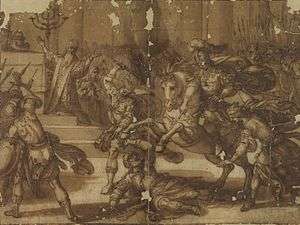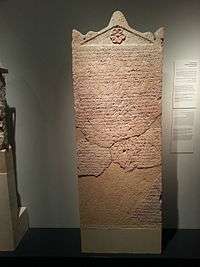Heliodorus (minister)
Heliodorus (Greek: Ἡλιόδωρος) was a legate of Seleucus IV Philopator c. 187 BC – 175 BC. Some historical sources say that he assassinated Seleucus and seized the throne for himself, before Antiochus IV Epiphanes, the brother of the late king, with the help of the Pergamon monarch, Eumenes II, recovered it.[1]
| Heliodorus | |
|---|---|
 Painting of Heliodorus being expelled from the temple | |
| King of the Seleucid Empire (King of Syria) | |
| Reign | 175 BC |
| Predecessor | Seleucus IV Philopator |
| Successor | Antiochus IV Epiphanes |
| Died | 175 BC |
| Occupation | Legate of Seleucus IV Philopator |
Biography
In the Deuterocanonical books
Around 178 BC Seleucus sent Heliodorus to Jerusalem to collect money to pay the Romans. There may be a reference to this in Daniel 11:20, "He will send out a tax collector to maintain the royal splendor". 2 Maccabees 3:21-28 reports that Heliodorus entered the Temple in Jerusalem in order to take its treasure, but was turned back by three spiritual beings who manifested themselves as human beings .
2 Maccabees 3:34-36 records that Heliodorus received "orders from God" to "proclaim to all men the majesty of God's power" .
Since you have been scourged by God, proclaim to all men the majesty of God's power - 2 Maccabees 3:34
Historical background

It is believed that on his return from Jerusalem, he killed the king and seized the throne for himself; but it was not long before Antiochus IV Epiphanes, the brother of the late king, with the help of the Pergamon monarch, Eumenes II, recovered it.[1]
The Heliodorus stele, a Greek-language inscription of the Israel Museum in Jerusalem, is dated to 178 BCE. In this stele, Seleucus informs Heliodorus that he appoints a certain Olympiodoros in charge of the temples of Coele-Syria and Phoenicia.[2] While this part of the inscription comes from the trade of antiquities, an additional fragment from the same inscription was found in 2005 in an underground basement of a Hellenistic house in Maresha.
Heliodorus in the Arts

During the Reformation and Counter-Reformation, the episode of The Expulsion of Heliodorus from the Temple was taken in Roman Catholic apologetics as a symbol of the inviolability of Church property.[3] For some time, it became a popular subject in works of artists, such as:
- Raphael (1512): Vatican, Palazzi Vaticani
- Wouter Crabeth (1566): Gouda (Holland), Sint Janskerk
- Bertholet Flémal (1662), Brussels (Belgium), Royal Museums of Fine Arts of Belgium
- Giuseppe Tortelli (1724): Brescia (Italy), Musei civici di Arte e Storia
- Francesco Solimena (1725): Naples (Italy), Gesù Nuovo
- Giambattista Tiepolo (1727): Verona (Italy), Museo di Castelvecchio
- Serafino Elmo (1734): Muro Leccese (Italy), Annunziata
- Franz Sigrist (1760): Zwiefalten (Germany), Klostenkirche
- Julius Schnorr von Karolsfeld (1860): Die Bibel in Bildern (Germany, Lutheran)
- Eugène Delacroix (1861): Paris (France), Saint Sulpice
Notes
- George Rawlinson, A manual of ancient history, 1880, 256.
- Letter of Seleukos IV to Heliodoros at attalus.org
- Gabriele Boccaccini, Portraits of Middle Judaism in Scholarship and Arts (Turin: Zamorani, 1992).
External links
![]()